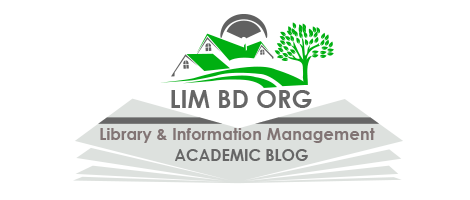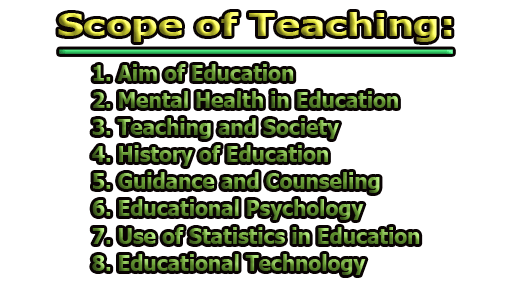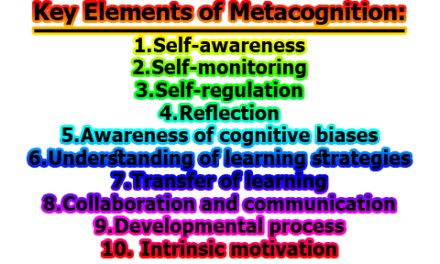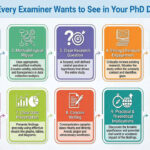Scope of Teaching:
Teaching is a multidimensional process that encompasses far more than the delivery of curriculum content. It involves shaping learners’ intellectual, emotional, and social development in alignment with broader educational goals. The scope of teaching includes various domains, such as the aim of education, mental health, societal needs, historical context, student guidance, psychological principles, statistical understanding, and the integration of educational technology. These dimensions collectively contribute to creating a holistic learning environment.
1. Aim of Education: The aims of education shape the curriculum, teaching methods, and learning outcomes. These aims differ based on philosophical, cultural, and societal values. Historically, education focused on the transmission of knowledge and moral values, but modern approaches emphasize critical thinking, creativity, democratic citizenship, and preparing learners for a complex global world (Noddings, 2013). Education is not a one-size-fits-all system; the aims should be flexible enough to accommodate the unique needs of students and the demands of a changing society.
Philosophers like John Dewey believed that education should be rooted in experience and aimed at preparing individuals for participation in democratic life (Dewey, 1938). On the other hand, more utilitarian perspectives see education as a tool for economic productivity and workforce development. In many contemporary education systems, there is a tension between these differing aims—between nurturing the individual and meeting the needs of the market.
Sample Questions:
- What should be the primary aim of education in the 21st century: personal growth, social cohesion, or economic productivity? Why?
- How do the aims of education differ across cultures or education systems?
- In your opinion, how can teachers balance the development of academic skills with moral and social values?
2. Mental Health in Education: Mental health in schools is increasingly recognized as crucial for learning. A student’s emotional and psychological well-being significantly impacts their ability to concentrate, process information, and build relationships. Schools are now seen as key environments for promoting mental health, as they reach a large population of young people during their formative years (World Health Organization, 2023).
Teachers, while not mental health specialists, play a critical role in early identification of issues such as anxiety, depression, or trauma. Classroom climates that are inclusive, respectful, and responsive to students’ emotional needs contribute positively to mental health. Moreover, programs like Social Emotional Learning (SEL) have been proven to reduce behavioral problems and enhance academic achievement (Durlak et al., 2011). Mental health training for educators is also becoming a priority in many countries.
Sample Questions:
- What signs might indicate that a student is experiencing mental health challenges?
- How can schools create a more mentally healthy environment for students and staff?
- Should mental health education be integrated into the school curriculum? If yes, at what grade level should it start?
3. Teaching and Society: Education does not occur in a vacuum; it reflects and shapes the society in which it operates. Teachers are not just knowledge providers; they are social agents who influence students’ attitudes toward equity, justice, and civic responsibility. Education systems both mirror and reproduce the values of society, whether consciously or unconsciously (Freire, 1970).
In diverse and pluralistic societies, teachers must adopt inclusive and culturally responsive teaching methods. This means acknowledging students’ cultural backgrounds, combating stereotypes, and promoting mutual respect. Furthermore, education can serve as a tool for social mobility—breaking cycles of poverty and marginalization when implemented equitably.
Global issues such as climate change, human rights, and social inequality are increasingly becoming part of school curricula, highlighting the growing importance of teaching for global citizenship.
Sample Questions:
- How does education influence social change in your community or country?
- What is the teacher’s role in promoting inclusivity and diversity in the classroom?
- Can education be truly neutral, or does it always reflect the values of the dominant society?
4. History of Education: The history of education reveals how educational philosophies, practices, and institutions have evolved in response to societal changes. Understanding these developments helps educators make informed decisions and appreciate the reasons behind current systems.
From the oral traditions of ancient societies to the formalized schools of ancient Greece, education has always been shaped by prevailing political, religious, and economic forces. For instance, the Prussian model influenced the structure of modern schooling, emphasizing discipline and uniformity to meet industrial-age needs (Gatto, 2010). In contrast, progressive movements, inspired by thinkers like Rousseau and Dewey, advocated for child-centered learning and experiential education (Cremin, 1961).
In many post-colonial contexts, education systems still carry remnants of colonial models, which often overlook indigenous knowledge and languages. Thus, history informs not only what is taught but also whose voices are prioritized.
Sample Questions:
- How have historical events or movements shaped your country’s education system?
- What can we learn from the successes and failures of past education reforms?
- In what ways does the current curriculum reflect historical biases or legacies?
5. Guidance and Counseling: Guidance and counseling are essential services that support students’ academic, personal, and career development. While teachers offer informal guidance through daily interactions, professional counselors provide structured, evidence-based interventions to help students navigate complex decisions and challenges.
According to Gysbers and Henderson (2012), comprehensive school counseling programs are most effective when they are developmental, proactive, and integrated into the educational mission. Good guidance programs help students understand themselves, develop interpersonal skills, and plan their academic and career paths effectively.
Counseling also plays a preventive role in addressing issues like bullying, stress, peer pressure, and family problems. When schools prioritize emotional and social support systems, they not only foster well-being but also enhance academic performance.
Sample Questions:
- What is the difference between guidance and counseling, and why are both important in schools?
- How can teachers collaborate with school counselors to support students more effectively?
- What barriers exist in implementing effective counseling services in your educational context?
6. Educational Psychology: Educational psychology explores how students learn and how teachers can facilitate learning through scientifically informed practices. It draws on theories of cognition, motivation, behavior, and development to optimize teaching strategies and learning environments.
Jean Piaget’s theory of cognitive development emphasizes that children learn in stages, while Lev Vygotsky highlights the importance of social interaction and scaffolding in learning through his Zone of Proximal Development (Slavin, 2020). These insights help teachers design developmentally appropriate and engaging lessons.
Furthermore, understanding motivation—both intrinsic and extrinsic—enables educators to encourage student engagement and persistence. Behavioral theories also help in managing classroom conduct and shaping positive behavior through reinforcement strategies.
Educational psychology is also foundational for assessing learning differences and supporting students with diverse needs, including those with learning disabilities or giftedness.
Sample Questions:
- How can knowledge of cognitive development improve teaching methods?
- What role does motivation play in student learning, and how can teachers enhance it?
- How should teaching strategies differ for students with learning difficulties?
7. Use of Statistics in Education: Statistics in education play a vital role in decision-making, assessment, research, and policy formation. Teachers and school administrators rely on statistical data to evaluate student performance, monitor progress, and improve instructional practices. Educational researchers use statistical methods to design studies, analyze results, and draw meaningful conclusions that inform evidence-based practices.
In classrooms, statistics help teachers interpret test scores, analyze trends in student performance, and assess the effectiveness of teaching strategies. For example, item analysis of test results can reveal which questions were too difficult or misleading, guiding improvements in assessment design.
On a broader level, education systems use statistical indicators—like literacy rates, dropout rates, and standardized test scores—to monitor national progress and allocate resources efficiently. Understanding and applying basic statistical concepts empowers educators to critically evaluate research, avoid misinterpretation of data, and make informed instructional decisions (Fraenkel, Wallen, & Hyun, 2012).
Sample Questions:
- How can statistical analysis improve classroom assessment and instruction?
- What are some common challenges teachers face when using data to inform practice?
- How can schools train educators to interpret and apply educational data effectively?
8. Educational Technology: Educational technology refers to the use of digital tools, platforms, and systems to enhance teaching and learning. Its role has grown significantly, particularly with the rise of e-learning, hybrid classrooms, and the integration of artificial intelligence in education.
Tools such as interactive whiteboards, virtual learning environments (e.g., Google Classroom, Moodle), and gamified apps like Kahoot or Quizlet have transformed how students engage with content. Technology also allows for personalized learning—adapting instruction to individual student pace and ability—and greater accessibility for students with special needs.
Beyond tools for delivery, educational technology supports communication, collaboration, and continuous feedback. During the COVID-19 pandemic, its importance was magnified as schools rapidly transitioned to remote instruction, revealing both its potential and the digital divide (Whalen, 2020).
To effectively use technology, teachers need digital literacy and pedagogical training. Merely introducing gadgets is not sufficient—there must be alignment with instructional goals and student needs (Selwyn, 2021).
Sample Questions:
- In what ways has technology improved or hindered the learning process in your classroom?
- What challenges do you face in integrating educational technology into your teaching?
- How can we ensure equitable access to digital tools and internet connectivity for all students?
It is apparent that the scope of teaching extends far beyond the classroom. It is an intricate blend of philosophical, psychological, societal, and technological elements. By embracing the aims of education, addressing mental health, understanding societal roles, considering historical contexts, offering guidance, applying psychology, using statistics, and integrating technology, teachers can provide comprehensive and meaningful education. A well-rounded understanding of these dimensions equips educators to meet the diverse needs of learners in an ever-evolving educational landscape.
References:
- Bowles, S., & Gintis, H. (1976). Schooling in capitalist America: Educational reform and the contradictions of economic life. New York, NY: Basic Books.
- Cremin, L. A. (1961). The Transformation of the School: Progressivism in American Education. New York: Alfred A. Knopf.
- Dewey, J. (1938). Experience and Education. New York: Macmillan Company.
- Durlak, J. A., Weissberg, R. P., Dymnicki, A. B., Taylor, R. D., & Schellinger, K. B. (2011). The impact of enhancing students’ social and emotional learning: A meta-analysis of school-based universal interventions. Child Development, 82(1), 405–432. https://doi.org/10.1111/j.1467-8624.2010.01564.x
- Fraenkel, J. R., Wallen, N. E., & Hyun, H. H. (2012). How to design and evaluate research in education (8th ed.). McGraw-Hill.
- Freire, P. (1970). Pedagogy of the Oppressed. New York: Seabury Press.
- Gatto, J. T. (2010). Weapons of mass instruction: A schoolteacher’s journey through the dark world of compulsory schooling. New Society Publishers.
- Gay, G. (2018). Culturally responsive teaching: Theory, research, and practice (3rd ed.). Teachers College Press.
- Gysbers, N. C., & Henderson, P. (2012). Developing and managing your school guidance and counseling program (5th ed.). American Counseling Association.
- Noddings, N. (2013). Education and democracy in the 21st century. Teachers College Press.
- Reinke, W. M., Stormont, M., Herman, K. C., Puri, R., & Goel, N. (2011). Supporting children’s mental health in schools: Teacher perceptions of needs, roles, and barriers. School Psychology Quarterly, 26(1), 1–13. https://doi.org/10.1037/a0022714
- Selwyn, N. (2021). Education and technology: Key issues and debates (3rd). Bloomsbury Publishing.
- Slavin, R. E. (2020). Educational psychology: Theory and practice (13th ed.). Pearson.
- Whalen, J. (2020). Should Teachers Be Trained in Emergency Remote Teaching? Lessons Learned from the COVID-19 Pandemic. Journal of Technology and Teacher Education, 28, 189-199.
- World Health Organization. (2023). How school systems can improve health and well-being: topic brief: substance use. https://www.who.int/publications/i/item/9789240064812

Library Lecturer at Nurul Amin Degree College










